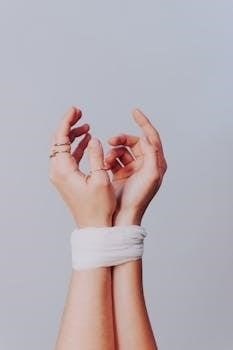Initial Rinse After Dyeing
After the tie-dye process, begin by rinsing the fabric under cold running water. Continue rinsing until the water runs clear, indicating that most of the loose dye has been removed. This is crucial for preventing color bleeding during the first wash.
Rinsing Under Cold Water
The initial rinse under cold water is a critical step in the tie-dye process. This action is designed to halt the dye reaction and prevent further staining of the fabric or other items during subsequent washing. Begin by placing the freshly dyed item under a stream of cold water, allowing the water to flow through the fabric. Gently manipulate the material to ensure all areas are thoroughly rinsed, paying special attention to folded or bunched areas. Continue this process until the water runs completely clear, indicating that the majority of the excess dye has been washed away. This step is crucial because it removes loose dye particles that could otherwise bleed onto other parts of the garment or other clothing items in the wash. The cold temperature is specifically used because it helps to set the dye that has already bonded with the fabric, preventing it from washing out. This initial cold rinse not only safeguards the colors of your tie-dye design but also protects the rest of your laundry load. It is better to rinse longer than to stop too soon.

Washing Machine Instructions
For machine washing tie-dyed items, it’s best to follow specific instructions. These steps help preserve the vibrant colors and prevent any dye from transferring to other garments. Proper machine washing ensures the longevity of your tie-dye creation.
First Wash Separately
The very first time you wash your newly tie-dyed item, it’s absolutely essential to wash it separately from all other clothing. This initial wash is crucial because there will likely be excess dye remaining in the fabric, even after the initial rinsing. Washing it alone prevents this excess dye from bleeding onto other garments, which could potentially stain them permanently. This step is important for maintaining the brightness and clarity of the colors in your other clothing. It also helps to preserve the unique design of your tie-dye project. By isolating your tie-dyed item for the first wash, you are taking the necessary precautions to protect the rest of your laundry. This simple step ensures that your other clothes remain pristine and free from any unwanted color transfer. This practice is highly recommended for all tie-dyed items, regardless of the fabric or the dyes used.
Cold Water Setting

When you are ready to wash your tie-dyed item, be sure to select the cold water setting on your washing machine. Using cold water for the first few washes is crucial to prevent the colors from fading or bleeding into other areas of the fabric or onto other garments if you accidentally include them. Hot water can cause the dye to release more easily, leading to a loss of vibrancy and potentially ruining the unique patterns you worked hard to create. Cold water helps to set the dye and ensures that the colors remain bright and bold. This is a simple step that can significantly impact the longevity and appearance of your tie-dye creation. Always double-check that your machine is set to cold before starting the wash cycle to protect your artwork.
Use Gentle Detergent
When washing your newly tie-dyed items, choosing a gentle detergent is essential to maintain the vibrancy of the colors and the integrity of the fabric. Harsh detergents can contain chemicals that may cause the dye to fade or bleed, diminishing the unique patterns you’ve created. Opt for a mild, dye-safe laundry detergent, or one specifically designed for delicates. It is best to avoid detergents with bleach or brighteners, as these can also affect the color of your tie-dye. A small amount of gentle detergent will be sufficient to clean your garment without being too aggressive on the dyes. This step will ensure your tie-dye stays looking fresh and vibrant for longer, preserving your artistic efforts and your clothing. Always carefully check the label of your detergent before using it to wash your tie-dye clothing.

Drying Methods
After washing, choose your drying method carefully. You can either let your tie-dye item air dry, which is gentle, or you can use a tumble dryer on a low-heat setting to avoid damage and fading.
Air Drying
Air drying is the gentlest method for preserving the vibrancy of your tie-dye. It minimizes the risk of shrinkage and fading, making it ideal for delicate fabrics or items with intricate designs. To air dry effectively, start by gently removing excess water from your freshly washed tie-dye piece, avoid wringing or twisting the fabric. Instead, consider carefully rolling it in a towel and pressing down to absorb moisture. Then, lay your tie-dye item flat on a clean, dry surface, or hang it on a clothesline or drying rack away from direct sunlight, which can cause colors to fade. Ensure there is enough airflow around the item to facilitate drying, and allow it to dry completely before storing or wearing. Air drying can take longer, but it’s the safest way to maintain your tie-dye’s unique look, especially for the first few drying cycles.
Low Heat Tumble Dry
If air drying isn’t feasible, using a low heat tumble dry setting is a suitable alternative. This method is quicker than air drying but requires care to avoid damaging the tie-dye. Before placing your tie-dye item in the dryer, ensure it’s already been thoroughly rinsed and washed separately. Select the lowest heat setting on your dryer to minimize color fading and shrinking. Avoid using high heat, which can harm the fabric and dull the vibrant colors of your design. It’s also a good idea to check the dryer frequently and remove the tie-dye piece while it’s still slightly damp to prevent over-drying. If possible, put your tie-dye garment in the dryer inside out to prevent further fading of the colors. Finally, remove the item promptly after drying to prevent wrinkles.

Long-Term Care
For lasting color vibrancy, wash your tie-dye with like colors in cold water. This prevents color bleeding onto other garments. Avoid harsh detergents and always skip fabric softeners and bleach, which can degrade the dye.
Wash with Like Colors
Once your tie-dyed items have been through their initial washes, it’s time to consider how to integrate them into your regular laundry routine. The key to maintaining the vibrancy and preventing unwanted color transfer is to wash your tie-dye pieces with like colors; This means grouping your brightly colored tie-dye garments with other brightly colored clothes, and separating them from whites or light pastels. Doing so will help to ensure that any residual dye that might still release during the washing process will only affect similar hues, preventing any unfortunate color accidents. It’s also important to note that even after multiple washes, some dyes may still have a tendency to release a small amount of color. Therefore, continuing to wash your tie-dye items with similar colors for the long term is a good practice to ensure they remain as vibrant as the day they were dyed and to protect your other clothing items from unwanted stains. This approach extends the life of your tie-dye masterpieces and preserves their unique designs.
Avoid Fabric Softeners and Bleach
When caring for your tie-dyed garments, it is crucial to avoid using fabric softeners and bleach during the washing process. Fabric softeners can negatively impact the dye’s vibrancy, potentially causing the colors to fade or become dull over time. These products often leave a coating on the fabric that can interfere with the dye’s integrity and reduce its overall brilliance. Bleach, on the other hand, is even more detrimental to tie-dye. It is a harsh chemical that can dramatically alter or completely remove the dye, leading to a significant loss of color and the unique design you worked hard to create. Instead of using these damaging additives, opt for a gentle detergent that is designed to preserve color. By steering clear of fabric softeners and bleach, you’ll ensure that your tie-dye clothing stays vibrant and colorful for longer, letting you enjoy your creations for years to come. This simple step is very important in the long-term maintenance of your dyed items.
